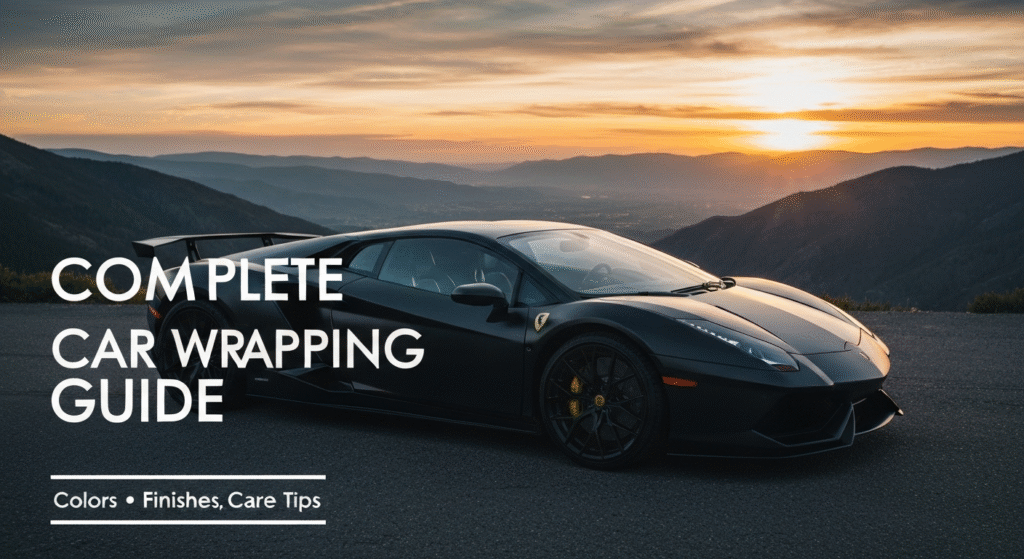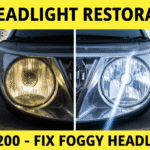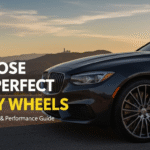Car wrapping has transformed from a niche automotive service into a mainstream way to customize vehicles. This process involves applying vinyl films to your car’s surface, creating stunning visual effects while protecting the original paint. Whether you want to change your car’s color completely or add unique graphics, wrapping offers flexibility that traditional paint jobs cannot match.
As someone who has worked in the automotive customization industry for over five years, I’m Sharmin, and I’ve witnessed firsthand how car wrapping technology has evolved. My experience spans from working with basic solid color wraps to complex textured finishes and custom designs. Through countless projects and client consultations, I’ve learned what works, what doesn’t, and how to help car owners make informed decisions about their vehicle customization.
What Is Car Wrapping and Why Choose It?
Car wrapping involves applying specialized vinyl film to your vehicle’s exterior surfaces. This film adheres to your car’s paint, creating a new appearance while keeping the original finish intact underneath. The process requires skill, patience, and the right materials to achieve professional results.
The popularity of car wrapping has exploded because it offers advantages traditional painting cannot provide. You can change your mind later and remove the wrap, revealing your original paint in excellent condition. This reversibility makes wrapping particularly attractive for lease vehicles or owners who like to change their car’s appearance regularly.
Professional installers use heat guns and specialized tools to stretch and conform the vinyl around curves, edges, and complex shapes. The material itself has improved dramatically over the past decade, with better adhesives, longer lifespans, and more finish options than ever before.
Key Benefits of Car Wrapping
- Paint Protection: The vinyl acts as a barrier against road debris, UV rays, and minor scratches
- Cost-Effective: Generally cheaper than high-quality paint jobs
- Reversible: Can be removed without damaging original paint
- Customization: Unlimited color and finish options
- Quick Installation: Takes 2-3 days versus weeks for paint
- Resale Value: Preserves original paint, potentially maintaining higher resale value
Popular Car Wrap Colors and Their Impact
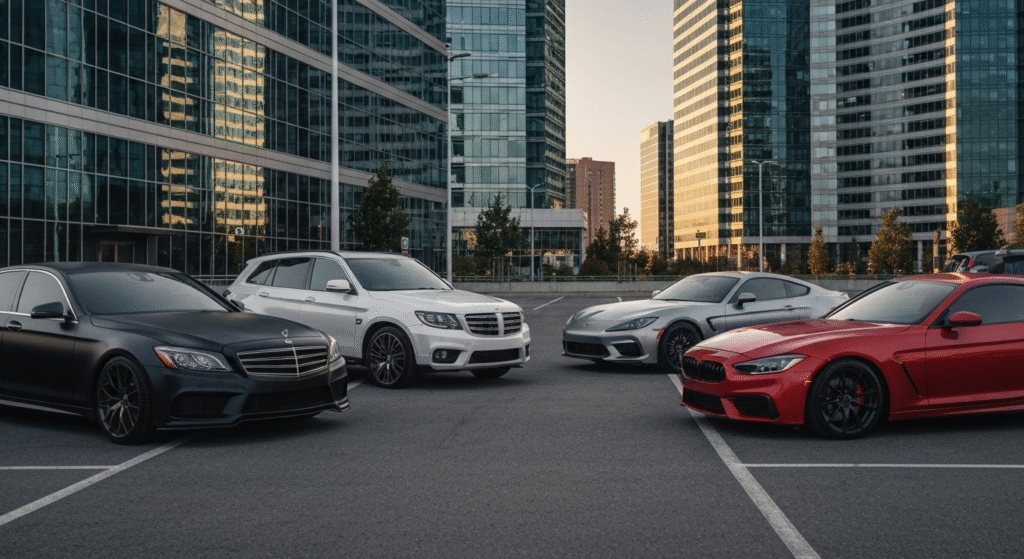
Color choice significantly affects your vehicle’s appearance and how others perceive it. From my experience helping clients select colors, certain choices consistently deliver better results than others.
Classic Solid Colors
Solid colors remain the most popular choice for first-time wrap customers. They provide a clean, sophisticated look that mimics expensive paint jobs. Black, white, and gray dominate this category because they work well with any vehicle style and maintain broad appeal.
Black wraps create an aggressive, premium appearance. They hide dirt well but show water spots and fingerprints easily. Many luxury car owners choose matte black to distinguish their vehicles from glossy factory finishes.
White wraps offer a clean, modern aesthetic. They stay cooler in hot climates and make vehicles appear larger. White shows dirt more readily but cleans easily with basic washing.
Gray options provide sophistication without the maintenance challenges of pure black or white. Charcoal and gunmetal gray have become increasingly popular for their versatility.
Bold and Vibrant Options
Bright colors make strong statements but require careful consideration. These choices work well for business vehicles, sports cars, or owners who want maximum attention.
Red wraps convey energy and passion. However, red fades faster than other colors when exposed to sunlight. Choose high-quality films with UV protection for longevity.
Blue variations range from navy to electric blue. Darker blues maintain professional appearance while brighter shades create sporty aesthetics.
Yellow and orange demand attention but can be challenging to match if repairs are needed. These colors work exceptionally well for commercial vehicles and race cars.
| Color Category | Maintenance Level | Visibility | Resale Impact | Best For |
|---|---|---|---|---|
| Black | High | Low | Neutral | Luxury vehicles |
| White | Medium | High | Positive | All vehicle types |
| Gray | Low | Medium | Positive | Professional use |
| Bright Colors | Medium | Very High | Variable | Sports cars, commercial |
Car Wrap Finishes: From Matte to Chrome
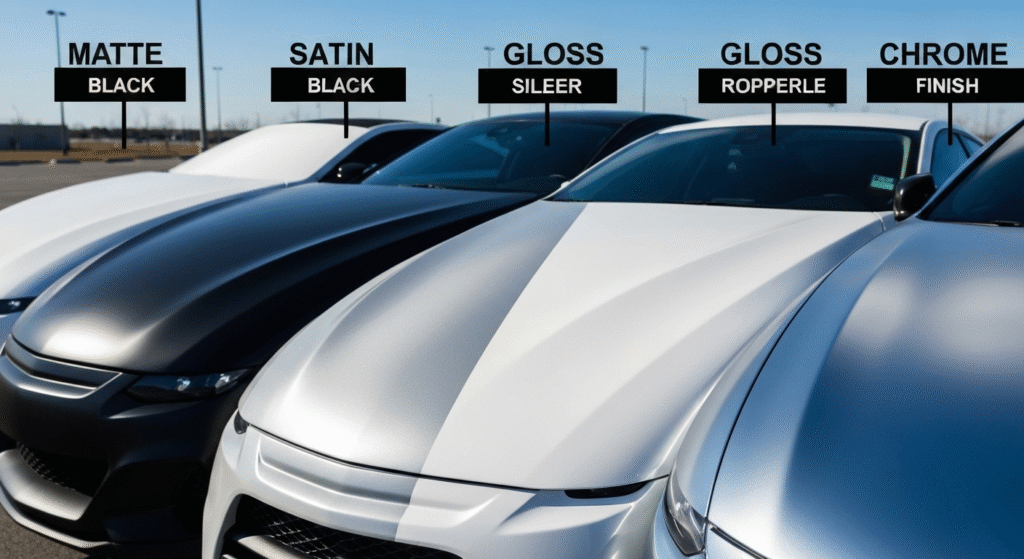
The finish you choose affects both appearance and maintenance requirements. Each option creates different visual effects and comes with specific care needs.
Matte Finishes
Matte wraps eliminate reflection, creating a sophisticated, non-glossy appearance. This finish has gained tremendous popularity because it looks expensive and hides minor imperfections well.
Matte black remains the most requested finish in my experience. It transforms any vehicle into something that looks custom and high-end. However, matte finishes require special care products designed specifically for non-glossy surfaces.
The key advantage of matte wraps is their ability to hide swirl marks and minor scratches that would be obvious on glossy surfaces. They also don’t show water spots as readily, making them more forgiving for daily drivers.
Satin Finishes
Satin provides a middle ground between matte and gloss. It offers subtle reflection without the high-maintenance requirements of fully glossy finishes. This option works well for owners who want something different but not too dramatic.
Satin finishes clean more easily than matte options while still providing that custom appearance. They’re particularly effective on curved surfaces where the slight reflection enhances the vehicle’s lines.
Gloss Options
High-gloss wraps mimic traditional automotive paint but offer more color options and easier installation. They provide the familiar shiny appearance most people expect from vehicles.
Gloss finishes show scratches and swirl marks more readily than other options. They require regular washing and occasional polishing to maintain their appearance. However, they’re the easiest to repair if damage occurs.
Specialty Finishes
Chrome and metallic finishes create dramatic effects but come with higher costs and maintenance requirements. These options work well for show cars or owners who want maximum visual impact.
Chrome wraps reflect like mirrors, creating stunning effects in sunlight. They’re extremely difficult to install properly and show every imperfection. Maintenance is intensive, requiring frequent cleaning to prevent water spots.
Carbon fiber patterns provide a high-tech appearance without the cost of real carbon fiber. These wraps work particularly well on sports cars and performance vehicles.
Textured finishes include options like brushed metal, leather, and wood grain. While unique, these specialty options can be difficult to clean and may trap dirt in their textures.
Professional Installation vs. DIY: What You Need to Know
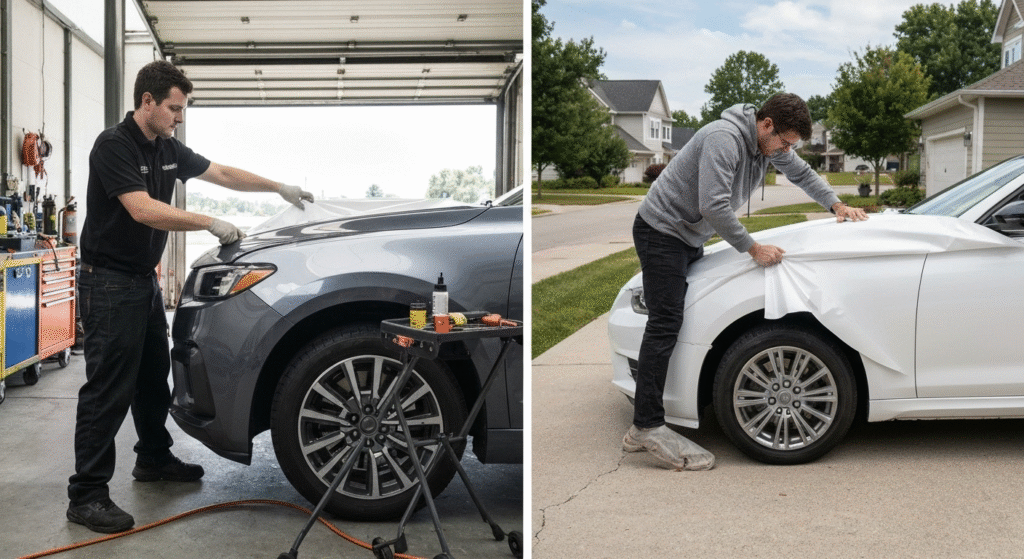
The installation process significantly impacts your wrap’s appearance and longevity. While DIY kits are available, professional installation typically produces better results.
Professional Installation Process
Professional installers follow systematic processes developed through years of experience. They start by thoroughly cleaning and preparing the vehicle’s surface, removing any wax, polish, or contaminants that could affect adhesion.
The installation environment matters enormously. Professional shops maintain controlled temperatures and dust-free conditions. They use specialized tools including heat guns, squeegees, and cutting implements designed specifically for vinyl work.
During my years in the industry, I’ve seen how proper preparation separates good installations from great ones. Professionals take time to remove trim pieces, door handles, and other components for complete coverage. They also know how to stretch material properly around complex curves without creating bubbles or wrinkles.
DIY Installation Considerations
DIY installation appeals to budget-conscious owners and those who enjoy hands-on projects. However, it requires patience, proper tools, and realistic expectations about results.
The main challenges involve working with compound curves, maintaining consistent temperature, and achieving professional-grade edges. Most DIY attempts succeed on flat surfaces but struggle with areas like bumpers, mirrors, and door handles.
Essential DIY tools include:
- High-quality squeegees
- Sharp cutting blades
- Heat gun or hair dryer
- Cleaning supplies
- Patience and time
Cost Comparison
| Installation Type | Cost Range | Time Required | Quality Level | Warranty |
|---|---|---|---|---|
| Professional | $2,500-$5,000 | 2-3 days | Excellent | 2-5 years |
| DIY | $500-$1,500 | 1-2 weeks | Variable | None |
Proper Care and Maintenance for Wrapped Vehicles
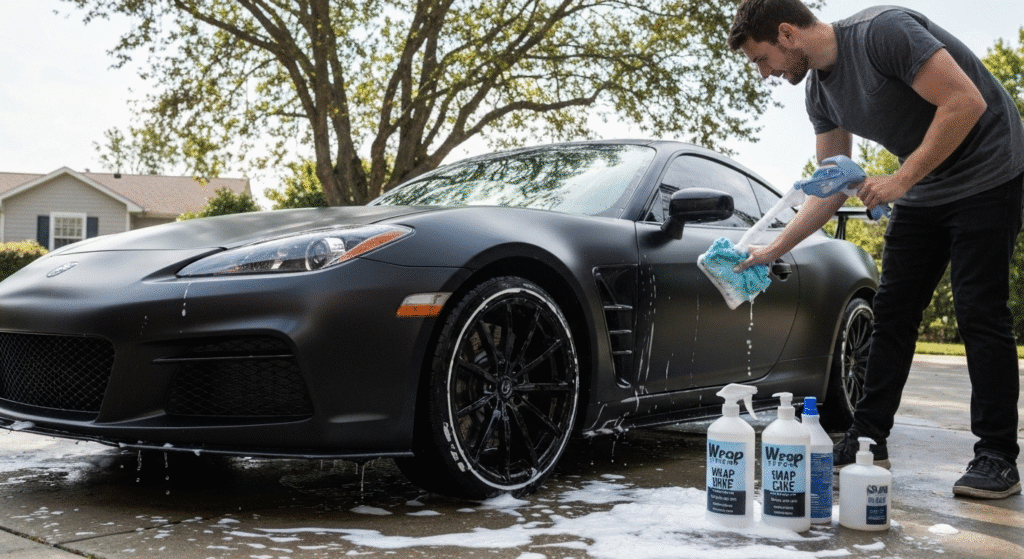
Maintaining your car wrap properly extends its life and keeps it looking fresh. Different finishes require specific care approaches, and using wrong products can cause permanent damage.
Daily Maintenance Practices
Regular washing prevents dirt buildup that can stain or damage wrap material. However, wrapped vehicles need gentler treatment than painted cars. Automatic car washes with brushes can scratch or lift wrap edges, so hand washing or touchless systems work best.
I always recommend washing wrapped vehicles weekly, or more frequently if exposed to harsh conditions. Use cool water and gentle automotive soap specifically designed for wrapped vehicles. Work from top to bottom, rinsing frequently to prevent soap from drying on the surface.
Pay special attention to wrap edges and seams where dirt accumulates. These areas are most vulnerable to lifting and require careful cleaning without aggressive scrubbing.
Cleaning Products and Techniques
The cleaning products you choose directly impact wrap longevity. Standard automotive soaps work for most wraps, but specialty cleaners designed for vinyl provide better results and additional protection.
Recommended products:
- pH-neutral automotive soap
- Microfiber wash mitts
- Soft-bristled brushes for textured areas
- Specialty wrap cleaning solutions
- Distilled water for final rinse
Avoid products containing petroleum distillates, which can break down vinyl adhesives over time. Also skip abrasive compounds, polishes, or waxes not specifically designed for wrapped vehicles.
Protecting Your Investment
Environmental factors pose the biggest threats to wrap longevity. UV exposure gradually breaks down vinyl materials, while extreme temperatures can cause expansion and contraction that stresses adhesive bonds.
Park in shaded areas when possible, or use car covers for long-term storage. In harsh climates, consider ceramic coatings designed for wrapped vehicles to provide additional UV and chemical protection.
Address damage quickly when it occurs. Small tears or lifted edges that seem minor can quickly become major problems if moisture gets underneath the wrap material.
Common Problems and Solutions
Even professionally installed wraps can develop issues over time. Understanding common problems helps you address them before they become serious.
Bubbling and Lifting
Bubbles typically indicate installation problems or adhesive failure. Small bubbles might disappear as the wrap settles, but larger ones usually require professional attention.
Edge lifting often results from inadequate cleaning during installation or exposure to high-pressure washing. Address lifting immediately by having edges re-adhered professionally.
Fading and Discoloration
Quality wraps resist fading for 5-7 years under normal conditions. However, constant sun exposure, especially in southern climates, can cause premature color changes.
Red and yellow wraps fade fastest, while blacks, whites, and grays maintain color longest. Choose wraps with built-in UV protection for maximum longevity.
Cleaning and Stain Issues
Different stains require specific treatment approaches. Tree sap, bird droppings, and tar need prompt attention to prevent permanent staining.
For stubborn stains, use isopropyl alcohol applied gently with soft cloths. Never use abrasive materials or harsh chemicals that could damage the wrap surface.
Cost Analysis: Wrap vs. Paint
Understanding the financial implications helps you make informed decisions about vehicle customization.
Initial Investment Comparison
Professional car wrapping typically costs less than high-quality paint jobs. However, prices vary significantly based on vehicle size, wrap complexity, and finish choice.
Basic color change wraps start around $2,500 for compact cars, while full wraps on large SUVs can exceed $5,000. Specialty finishes like chrome or textured materials add 30-50% to base prices.
Equivalent paint jobs often cost $3,000-$8,000 or more, especially for custom colors or multiple coats. Premium paint jobs requiring bodywork can easily exceed $10,000.
Long-term Value Considerations
Wraps preserve original paint, potentially maintaining higher resale values. This benefit is particularly significant for lease vehicles or owners who change cars frequently.
However, paint jobs last longer than wraps. Quality paint can look good for 10-15 years with proper care, while wraps typically need replacement after 5-7 years.
| Factor | Car Wrap | Paint Job |
|---|---|---|
| Initial Cost | $2,500-$5,000 | $3,000-$8,000+ |
| Lifespan | 5-7 years | 10-15 years |
| Reversibility | Yes | No |
| Resale Impact | Positive | Variable |
| Maintenance | Moderate | Low |
Frequently Asked Questions
How long does a car wrap last? Quality wraps typically last 5-7 years with proper care. Factors like climate, usage, and maintenance significantly impact longevity.
Can I wash my wrapped car normally? Yes, but use gentle methods. Hand washing or touchless car washes work best. Avoid aggressive brushes and high-pressure spraying directly at edges.
Will wrapping damage my original paint? Professional installation and removal should not damage healthy paint. However, wraps can remove failing or poor-quality paint when removed.
How much does professional wrap removal cost? Removal typically costs $500-$1,200 depending on wrap age and vehicle size. Older wraps require more labor and may need adhesive removal treatments.
Conclusion
Car wrapping offers an excellent way to customize your vehicle while protecting its original finish. Success depends on choosing appropriate colors and finishes for your needs, ensuring professional installation, and maintaining the wrap properly throughout its life.
The investment pays off through enhanced appearance, paint protection, and preserved resale value. Whether you choose subtle color changes or dramatic specialty finishes, wrapping provides flexibility that traditional paint cannot match.
Consider your budget, maintenance preferences, and long-term plans when making decisions. With proper planning and care, a quality wrap will transform your vehicle and provide years of satisfaction.

